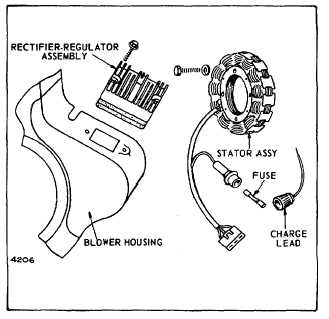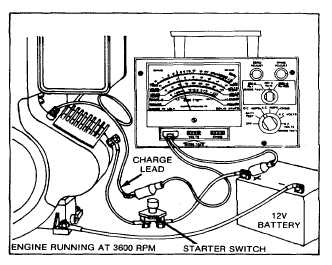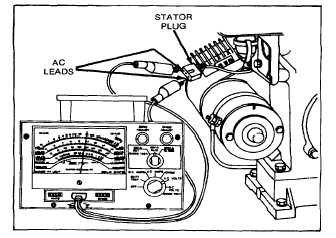ALTERNATOR
10 Amp-Fuse Type
10 AMP REGULATED ALTERNATOR
Used on Model Series 320400
This completely self-contained 10 ampere regulated
alternator uses both solid state rectifier and electronic
regulating elements. It provides rapid charging and
handles extra electrical loads without overcharging the
battery. Its output rises from 4.2 amperes at 2000 RPM
to 10 amperes at 3600 RPM. It uses less than 0.2
horsepower.
Fig. 220 - Alternator Assembly
CHECKING 10 AMP REGULATED ALTERNATOR
Condition Found (Fuse Blown)
Check if battery polarity is correct. Negative (-) side of
battery should be grounded to engine or frame; positive
(+) side of battery to alternator output lead.
If reversed, correct and put in new fuse.
WHEN
CHECKING
THE
ALTERNATOR
COMPONENTS,
MAKE
THE
TESTS
IN
THE
FOLLOWING SEQUENCE:
Condition Found (Fuse Blown)
Disconnect charging lead from battery. Connect a DC
ammeter between charging lead and battery, as shown
in Fig. 221.
Fig. 221 - Testing for Output
Start engine and run at 3600 RPM. An ammeter reading
of 10 amps or above indicates alternator is functioning.
Check battery, cables, etc. If ammeter reading is less
than 10 amps, stator or rectifier-regulator is defective.
Testing Stator
Disconnect plug from regulator-rectifier assembly. Start
engine and run at 3600 RPM. Connect AC volt meter to
AC terminals at stator plug. See Fig. 222. A meter
reading above 20 volts indicates stator is good. A volt
meter reading less than 20 volts indicates stator is
defective. Check for shorted leads or obvious defects. If
shorted leads are found, repair with electrical tape. If
visible defect is not found, replace stator.
Fig. 222 - Testing Stator
68





